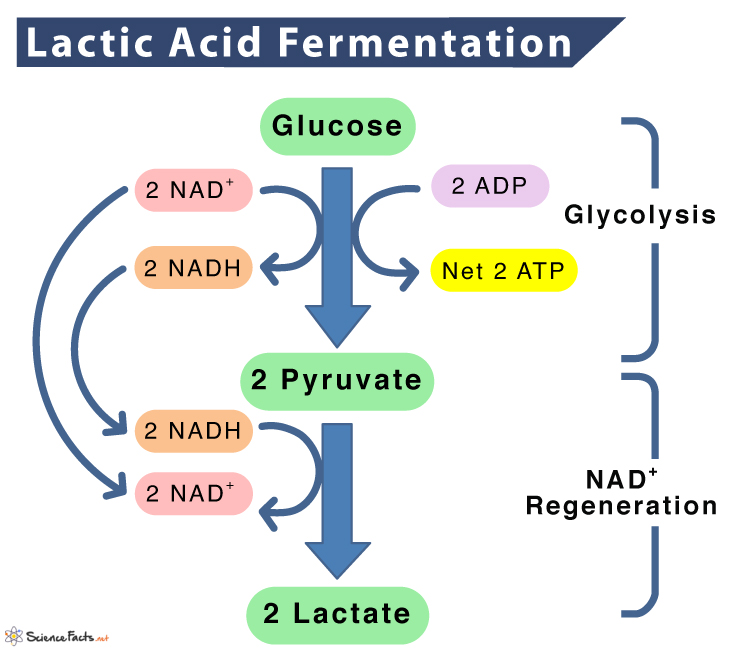A typical example of lactic acid fermentation is making yogurt by the bacteria Lactobacillus.
History of Lactic Acid Fermentation
Where and When Does It Occur
Process of Lactic Acid Fermentation
Other Lactic Acid Fermentations
Uses of Lactic Acid Fermentation
Lactic Acid Fermentation vs. Alcoholic Fermentation
In Bacteria Bacteria that carry out lactic acid fermentation are commonly referred to as Lactic Acid Bacteria (LABs). This process is a survival strategy in those bacteria as it produces the energy required for their metabolism and helps them reduce the pH of their environment through the synthesis of lactic acid. Such an acidic condition makes the environment unsuitable for other microorganisms, thus reducing their growth competition. While some bacteria are strictly anaerobic, some can switch between aerobic and anaerobic-based respiration depending on oxygen availability. In Animal Cells When muscle cells have insufficient oxygen supply during vigorous exercises, cells undergo anaerobic respiration to meet their energy demand. Through this anaerobic respiration, lactic acid, a byproduct, accumulates in the muscles, causing weakness and a burning sensation. Besides muscle cells, lactic acid fermentation also occurs in red blood cells (RBCs) as they lack mitochondria to produce energy aerobically. Step 1: Glycolysis It involves the conversion of glucose to 2 molecules of pyruvic acid, creating 2 ATP and 2 NADH. Glycolysis occurs in the absence of oxygen. NADH acts as the electron carrier, and pyruvate is the final electron acceptor in lactic acid fermentation. Glucose + 2 ATP + 2 NAD+ -> 2 Pyruvic acid + 2 NADH + 2 ATP……. (1) Step 2: Conversion of Pyruvic Acid to Lactic Acid Each pyruvic acid molecule is converted to lactic acid producing 4NAD+ as the byproduct. 2 of the NAD+ go back to continue glycolysis. This reaction occurs in the presence of the enzyme lactate dehydrogenase. 2 Pyruvic acid + 4 NADH -> 2 C3H6O3 (Lactic Acid) + 4 NAD+ ……. (2) From equations (1) and (2), we get the lactic acid formation equation: Glucose + ADP + NADH -> C3H6O3 (Lactic Acid) + ATP + NAD+ This lactic acid fermentation pathway where glucose is first broken down to pyruvate by glycolysis, then the glucose to pyruvate producing 2 ATPs is called homolactic acid fermentation. This pathway is commonly employed by some Lactobacilli, Pediococcus, and Streptococcus species. Heterolactic Acid Fermentation is similar to homolactic fermentation. However, instead of 2 lactic acid molecules, only one molecule of lactic acid is synthesized, along with a molecule each of ethanol and carbon dioxide. The equation of heterolactic acid fermentation is: Glucose + ADP -> 2 C3H6O3 (Lactic Acid) + C2H5OH + Ethanol + CO2 + ATP Bifidium Pathway, or the Bifidobacterium shunt pathway, produces acetate and lactate as byproducts and is produced by Bifidobacteria. The equation is: 2 Glucose + 5 ADP -> 3 Acetate + 2 C3H6O3 (Lactic Acid) + 5 ATP Also, lactic acid fermentation helps certain bacteria such as Lactobacilli carry out respiration even without oxygen. Thus, lactic acid fermentation serves as a rescue pathway in bacteria, animals, and humans. This type of fermentation has a high commercial use. It is widely used in the industry to produce fermented food products and beverages, for example, yogurt, cheese, fermented pickles (such as kimchi, sauerkraut), soy sauce, and sourdough bread.
